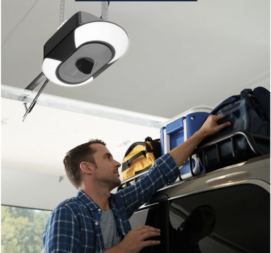
A garage door opener might seem like an afterthought, until the day it stops working. The simple pleasure of pressing a button to navigate your car in and out of the garage can become a vexing chore without it. But these humble devices offer much more than just convenience. A smart garage door opener provides security and control even when you are away from home. Security in garage doors is a critical, yet often overlooked, aspect of home safety. If your garage is attached to your house, or if you store valuable items there, the significance of a secure garage door is paramount. A sturdy, well-maintained garage door can significantly deter burglaries or theft and the heart of a secure garage door system is the garage door opener.
Different types of garage door openers

The type of garage door opener you choose depends on your garage’s layout and personal preference. You have the option of a side mount garage door opener or a wall mount garage door opener. Both are solid choices, but determining the ‘best garage door opener’ is subjective and heavily dependent on individual needs and garage specifications.
Garage door openers today come with a variety of features designed to simplify your life. The ubiquitous garage door opener remote allows you to operate your garage door from a distance, sparing you the trouble of manual labour. For those who prefer tech-savvy solutions, a Wi-Fi garage door opener or a smart garage door opener such as those from Chamberlain or Skylink will allow you to control your garage door directly from your smartphone, regardless of your location.
How safe are garage door openers?
Modern garage door openers are equipped with numerous safety features. These include rolling codes that change each time the opener is used, making it near impossible for potential intruders to gain access. Some openers even come with vacation modes that disable remote controls, ensuring the garage door can’t be opened in your absence. Additional essential features to consider include a garage door opener keypad, which provides an alternate way to access your garage, and a garage door opener battery that ensures operation even during power outages.
Step-by-step guide to installing a garage door opener
One common question homeowners ask is, “Can you install a garage door opener yourself?” While technically possible, the complexity of the task varies based on the model and your handyman skills.
Should you decide to embark on the task, this how-to guide on garage door opener installation provides basic steps that could prove useful:
- Gather your tools: Before starting, gather all the necessary tools. You’ll likely need a drill, ladder, level, tape measure, wrenches, pliers, and screwdrivers.
- Understand your opener: Not all garage door openers are the same. Familiarize yourself with the parts and read the installation manual thoroughly.
- Attach the rail to the motor unit: The rail is the long piece that guides and supports the chain, belt, or rod. It needs to be securely connected to the motor unit.
- Attach the trolley to the rail: The trolley is the piece that moves along the rail to open and close the door.
- Mount the header bracket: This bracket needs to be securely attached to the wall above the garage door.
- Attach the rail to the header bracket: This involves ensuring the rail is perfectly level before securing it.
- Attach the pulley assembly: This includes the pulley, the rope, and the straight door arm.
- Install the power unit: The power unit should be high enough that you don’t hit it with your vehicle, usually at least 7 feet from the floor. It may need to be suspended from the garage ceiling with metal brackets.
- Connect the opener to the door: The final step is connecting the opener to the door using the curved door arm and the bracket that you attach to the door.
Remember, while these steps provide a general guide, always follow the manufacturer’s instructions when installing a garage door opener. If you’re unsure, consider hiring a professional to ensure safe and correct installation.
Maintaining your garage door opener

A crucial aspect of extending the lifespan of your garage door opener is regular maintenance. This includes routine tasks like replacing the garage door opener battery, greasing the moving parts, and occasionally switching out the garage door opener remote.
Belt drive reliability
Belt drive garage door openers, known for their reliability, use a rubber belt to slide the trolley when the door is activated. As a result, they operate more quietly and smoothly than their chain-drive counterparts. So, are belt drive garage door openers reliable? Absolutely. Though they might have a slightly higher upfront cost, they often require less maintenance and offer superior longevity, making them a sound investment for many homeowners.
Selecting a garage door opener for your home
Though often taken for granted, garage door openers play a vital role in both the convenience and security of your home. By selecting the right opener and ensuring it’s well-maintained, you can enjoy secure and efficient operation for years to come!
Choosing the best garage door opener for your home is a matter of considering factors like the type and size of your garage door, the noise level you find acceptable, the security features offered, and whether you want smart technology. You can find a range of garage door openers on bestbuy.ca to find the one that fits your needs.
This article was drafted using AI technology and then reviewed, fact-checked, and revised by a member of our editorial team.




